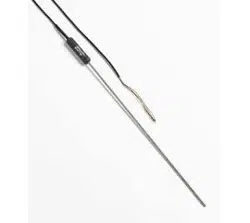Loading ...
Loading ...
Loading ...

6 Operation
6.1 General
For best results, be familiar with the operation of the calibration bath or furnace
and the read-out instrument. Be sure to follow the manufacturer’s instructions
for the read-out instrument and the calibration bath or furnace.
6.2 Comparison Calibration of Other Instruments
The uniformity and stability of the bath and the degree of accuracy required de
-
termine the number of temperature measurements necessary. However, to fol
-
low “good” practice procedures, always measure the triple point of water (R
tp
)
after each temperature measurement. This provides the most accurate measure
-
ment of the ratio:
Wt
Rt
Rtp
()
()
()
=
Equation 1: Resistance Ratio Equation
6.3 Immersion Requirements
Stem effect can cause measurement errors for any thermometer not immersed
in the fluid at least 152 mm (6 inches). This error is due to heat lost or gained
by the sensing element through the thermometer stem. In addition, heat losses
occur due to radiation losses from the sensing element to the housing. How-
ever, the effect of the shunt resistance is insignificant. Full immersion is recom
-
mended in a furnace or freeze point cell.
The immersion depth for primary standards is dependent on several factors in
-
cluding accuracy requirements and type of liquid. Therefore, we recommend a
203 mm (8 inch) minimum immersion depth.
The exact immersion depth required can be determined by performing a gradi
-
ent test taking measurements approximately every 127 mm (0.5 inch) until
there is a significant difference in readings. Allow the thermometer to stabilize
at each new depth. Plot the results to see the stem effect.
6.4 Thermal EMF
Two factors contribute to thermal EMF, chemical consistency and physical con
-
sistency. Variations in chemical structure and discrepancies in crystal structure
due to impurities can contribute to thermal EMF. These factors are minimized
by annealing the full length of wire before construction of the SPRT.
Likewise, connection to extension lead wires and readout instruments can be a
source of thermal EMF. The thermal EMF is caused by a difference in tempera
-
15
6 Operation
General
1.888.610.7664 sales@GlobalTestSupply.com
Fluke-Direct.com
Loading ...
Loading ...
Loading ...
